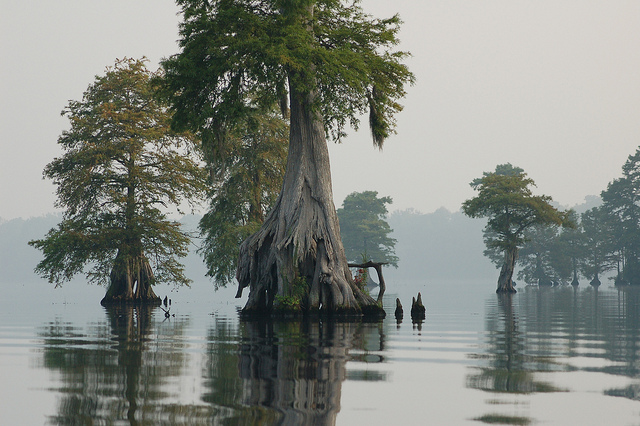See also: Dismal Swamp Canal; Great Dismal Swamp

The Great Dismal Swamp is a large area of natural swampland. It sits on the border between Virginia and North Carolina. It is in the coastal plain and very close to the Atlantic Ocean. The swamp is home to many species of birds, mammals, insects, reptiles, trees and plants. It also has a long history of use and modification by people. Do you wonder why it's called the Great Dismal Swamp?
History of people in the Great Dismal Swamp
Before the 1800s the swamp was an enormous area of wetlands and forest. It supported many species of birds, mammals, reptiles, fish and plants. It covered more than 2,000 square miles. And the area around it was home to Native American peoples for about 10,000 years.
Conflict between tribes and European settlers drove tribes off their lands. Some found safety in the swamp. They established settlements and communities and lived off abundant game and fish. Some continued to trade with Europeans settlers. Today some descendants of those tribes still live in North Carolina and Virginia.
The Dismal Swamp became a safe place for freedom seeking enslaved people and free persons of color. They could hide there and seek safety. Some hid in the swamp on their journey to the north to freedom. Others stayed and lived in the swamp area and established their own communities. Both Africans and Native Americans found abundant resources in the swamp area.
In the 1730s, colonists wanted to tame the swamp for farming and industry. They wanted to drain the swamp in some places and build a canal to carry barges with supplies and people. People who supported the effort included George Washington, Thomas Jefferson and Patrick Henry.
Construction of a canal finally began in 1793 from both Virginia and North Carolina. Known as the Dismal Swamp Canal, it was completed when both sides met in the middle in 1805. It was a long difficult process, and it used the labor of enslaved black people to complete the work. Canal workers suffered horrible conditions. These included high temperatures in the summer, injuries and exhaustion, and bites by venomous snakes. The completed Dismal Swamp Canal was 22 miles long. It stretched from Chesapeake, Virginia to South Mills, North Carolina.
The first barge to successfully make it from one end to the other made the trip in 1814. The canal carried supplies and passenger barges between the two states. When rail travel become more common and efficient in 1880s, the canal had much less traffic. And eventually it stopped being used for shipping. Today the canal is part of the intercoastal waterway. And it is used for recreational boats.
Nature in the Great Dismal Swamp
Today the Dismal Swamp area is only a fraction of the size it was before the 1700s. Human beings have changed the landscape. They did this by building the canal, draining areas, and logging.
Before the arrival of Europeans, the area was home to hundreds of plant and wildlife species. Even panthers lived in the area. A round natural lake sits near the center of the swamp, called Lake Drummond. And although people associate alligators with swamps, no alligators actually live in the swamp.
Today the swamp is home to approximately 97 different species. These include rattlesnakes, eagles and many species of endangered birds. There are more than 43 species of butterflies!
The swamp area is now protected. You can visit these natural areas at the Great Dismal Swamp National Wildlife Refuge and Dismal Swamp State Park in North Carolina.